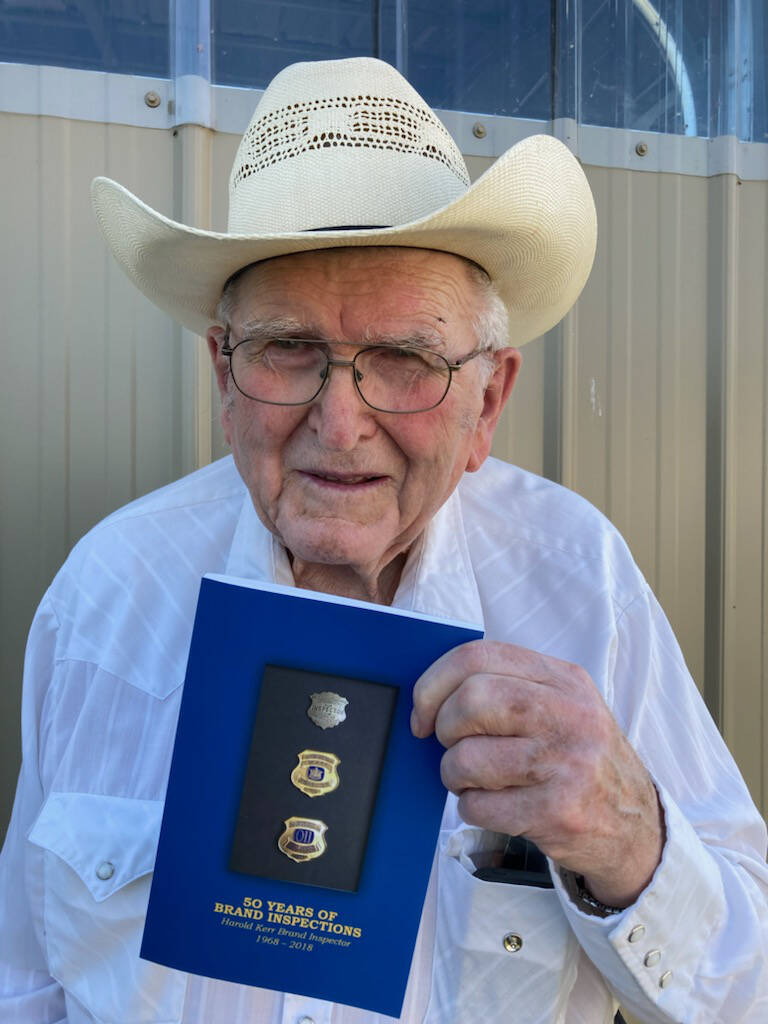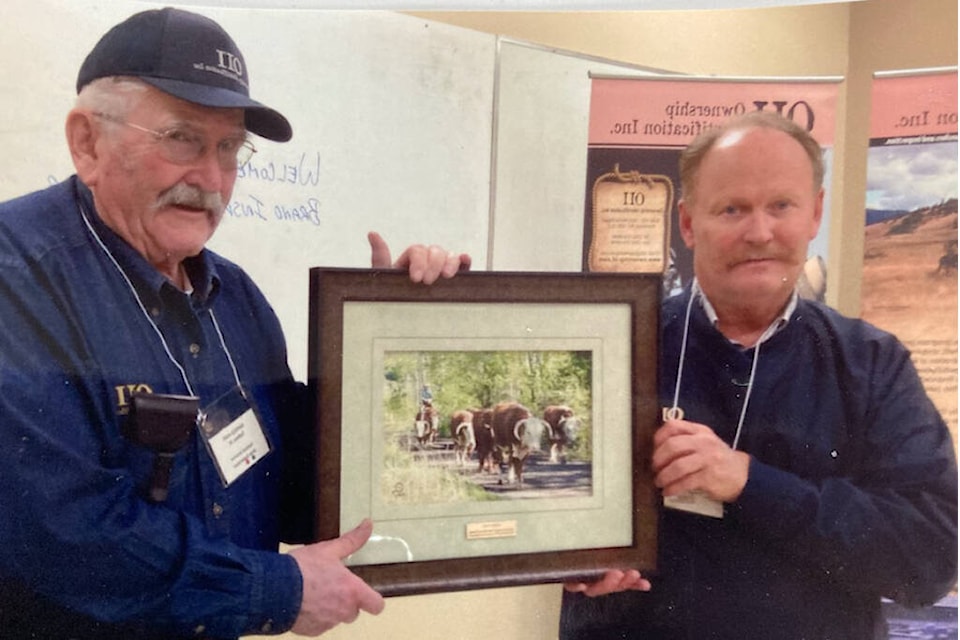A couple of months back I got a call from Harold Kerr. He has written a book, 50 Years of Brand Inspections, and he wanted me to do a column on his adventures as a brand inspector.
I had an opportunity, years back, to work as a ranch hand for the 108 Ranch just outside of 100 Mile House. I spent a couple of days holding calves down as their brand was applied.
Burning hide aroma and manure flowing steadily as momma cow made bluff charges to get her baby back, I wondered if the brand was functional or just a cattlemen’s tradition.
According to Harold, it is totally functional. All cattle or horses that are to be shipped or sold locally need to be inspected by the brand inspector. The brand designates ownership.
Harold was born into the cattle business right here in Quick B.C. His father, Angus, moved out from Ontario to join his brother ranching and hacking ties.
When Harold was in school in Telkwa he had already decided what he was going to do when he grew up. The business of hauling cattle to market was changing from trains to trucks and Harold wanted to be part of that change.
Later, Harold had a chance to go to the University of British Columbia as part of a rural program to show country kids what was available for education. He was encouraged to organize the 4H program in his community.
On returning to Quick, he did what was requested and assisted several folks to start up the 4H program. It was through the program that Harold met his wife Sharon and they embarked on a marriage of 50-plus years. They settled on property just up from the Quick Bridge on the east road and developed a bonafide cattle ranching business that is still producing today.
Running cattle is a full-time job. Preparing crops, cutting and baling hay, moving stock to range, building barns, repairing equipment. When was there time to take on a job as brand inspector on call 24/7.
“Well, I thought it would bring in some much-needed cash to our operation and it would allow me to do what I liked most, working with cattle and working with like-minded, interesting people,” Harold said.
So, with Sharon’s blessing, Harold took the job and never looked back. When he was on the road, Sharon and their two boys, Dallas and Colin would pick up the slack.
Harold’s territory extended from Rose Lake in the east to Haida Gwaii in the west to the Yukon border in the north.
The job primarily included documenting brands to verify ownership, but also entailed administering the Fenceline Act, the Trespass Act, the Pound Act, the Animal Disease Act, the Fur farm Act and any other legislation the Department of Agriculture needed to enforce.
Harold recalls even checking dairy farms for buildings with pressure-treated wood.
It seems the chromate copper arsenate had been leaching arsenic and milk samples were showing contamination. The provincial government ordered the industry to stop using these products and eventually eliminated this contamination.
Over the years, Harold kept close ties with 4H and even found time to be president of the local Cattlemen’s Association. He was also a local director for the Regional District Association.
“It is important to be involved and volunteer,” Harold said. “I have met so many interesting people through these organizations.”
In 1997, the B.C. Ministry of Agriculture Fisheries and Foods turned over the inspection of livestock to the private company Ownership Inspection I (OII) and Harold officially retired, but continued on as a contractor for the new company.
Reflections on his almost 3o years in the brand inspection game to that point appeared in the cattlemen’s magazine Beef in B.C. that fall, written by Harold’s wife Sharon.
In the article, she notes that inspecting livestock can be “frustrating, dangerous, satisfying, annoying, and, at times, outright funny.”
She recounts a tale of Harold going to a small ranch to inspect five cows.
“When he arrived, the cows were in a small pasture near the road but Kerr noted a distinct lack of loading facilities,” she wrote. “The truck arrived and the owners of the cattle instructed the truck driver to back the liner into a low spot at the corner of the fence and constructed the loading chute on site. Two grader blades covered with a sheet of plywood made the floor and with the addition of a piece of plywood on each side, the chute was complete.
“Scattering a little feed for ‘bait,’ the owners brought the cattle forward warning the trucker and brand inspector that one cow was really wild and the bull was vicious and not to be trusted. Tempted by the feed four of the cows eventually obliged the trucker and followed the feed into the liner.
“The wild cow blew past the owners and headed back for greener pastures while the bull calmly pushed past them and sauntered away. Undaunted the wranglers disappeared for a few minutes and returned with two pieces of 2X2 about sixteen feet long.
“With one person on each end of the narrow boards they proceeded to direct the bull along the fence in the direction of the truck. The bull put his head over the top rail and made motions that he would jump. With a harmonized effort the two raised the side of the portable corral and the bull backed off.
“Next, he tried putting his head between the rails in an attempt to push through. The owners quickly brought the 2X2s closer together and foiled his effort. His attempt to go under the rails saw the pair lower their fence and keep the bull confined.
“Apparently feeling defeated, the ‘vicious’ bull proceeded to board the liner and ride with the cows that were already loaded. Meantime the wild cow was placidly eating grass in the pasture. With a little help, the owners of the cow got her back into the area where the truck was loading and tried pointing her in the direction of the ‘chute.’
“Preferring to be free, the cow left the pasture once more. Disappointed that the cow was ‘too wild’ to load in the truck and relating their intention to shoot her right there, Kerr then heard them confide in the trucker, ‘You wouldn’t believe that cow is broke to lead would you?’”
Later, Sharon encouraged Harold to gather some stories together for his book. This is something that all oldtimers need to do, put their history in print, he believes.
Throughout 50 Years of Brand Inspections, you can feel Harold’s character portray itself. His respect for the law and concern for the humane treatment of animals is foremost.
The branding system was developed to protect farmers from loss and proved important in contributing to the quality of Canada’s cattle and maintaining our international reputation in the industry, says Harold.
Harold’s book is full of the many incidents he has encountered throughout his career, some funny, some not so funny. He has dedicated the book to his wife Sharon who passed away three years ago.
Without her encouragement, the tale would not have been told.
The book is available at the Smithers Museum, Out of Hand store and the Mountain Eagle Books or give Harold a call at 250-847-1215 on his cell.
- With files from Thom Barker

